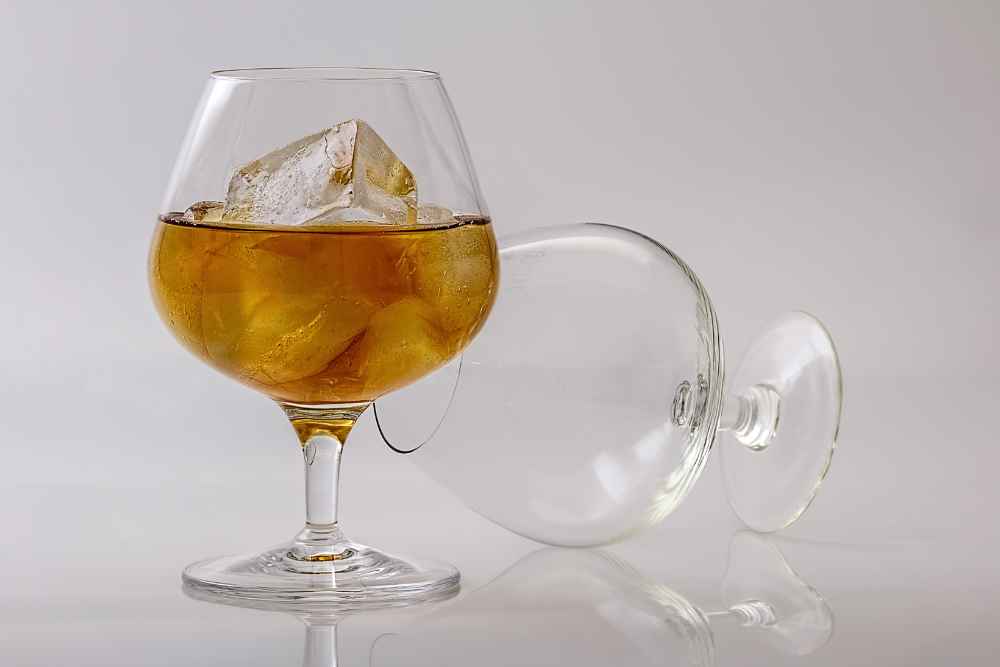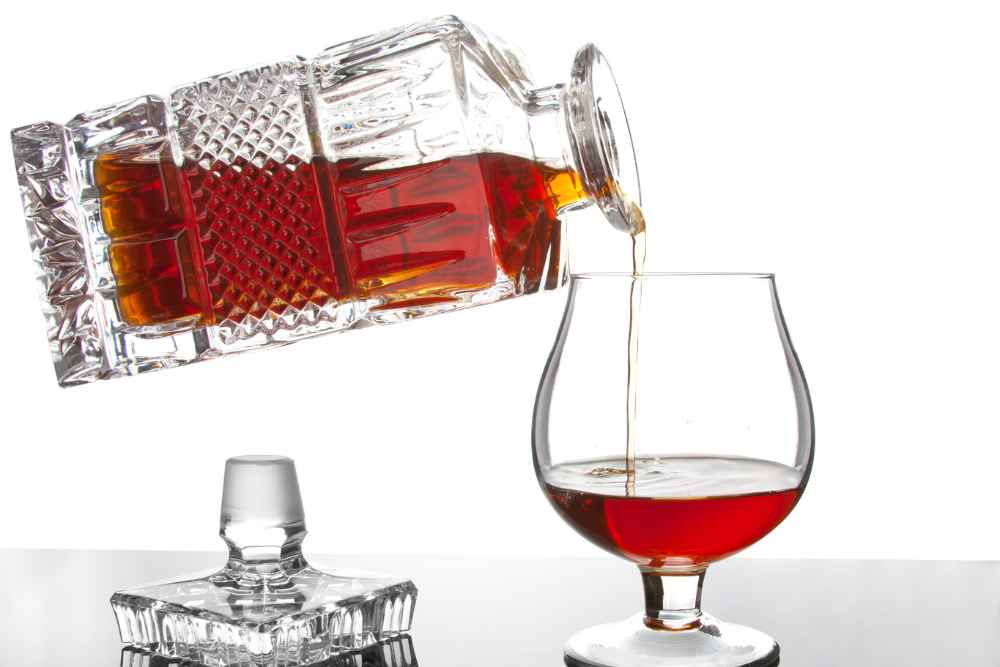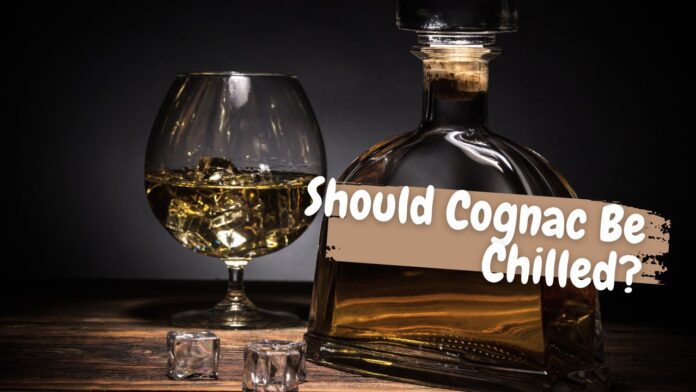This page may contain affiliate links. Please see our Disclaimer for more information. Always drink responsibly and adhere to your local legal drinking age.
Introduction: The Age-old Debate Over Whether To Chill Cognac Or Not
Cognac has long been a symbol of sophistication and class, but as tastes evolve in the 21st century, so does the question: should cognac be chilled? This seemingly simple query raises eyebrows amongst enthusiasts who love to savor this delectable spirit.
As you journey with us through the rich history and unique characteristics of cognac, we’ll finally settle the debate on whether cooling your favorite tipple enhances or detracts from its flavor experience.
Key Takeaways:
- Cognac should be served at room temperature to appreciate its complex flavors and aromas fully.
- Chilling cognac can numb the palate, alter the texture, and disrupt flavor balance.
- The optimal serving temperature for young vs. old cognacs is 61 – 72°F.
- Pairing cognac with foods like red fruits or fatty cheese can enhance the taste experience.
Understanding Cognac
Cognac is a type of brandy made exclusively in the Cognac region of France, using specific grape varieties and distillation methods.
How Cognac Is Made
Cognac production is a meticulous process, beginning with the cultivation of Ugni Blanc grapes in the Cognac region of France. After harvesting, these grapes are fermented into wine, which typically has a low alcohol content, around 8-12%.
The eau-de-vie is aged for at least two years in oak barrels, during which time it develops its unique flavor profile and rich amber color. To maintain consistency and quality, distillation must be completed by March 31st, following the harvest season.
Throughout this aging process, master blenders monitor the development and nuances of each batch to ensure an exceptional final product worthy of being called Cognac.
Unique Characteristics Of Cognac
Cognac’s unique characteristics set it apart from other spirits, giving it a prestigious reputation among cocktail drinkers. For starters, Cognac is produced in the famed region of France that shares its name and must adhere to strict production laws, much like Champagne.
One key factor contributing to Cognac’s distinct flavor profile lies in blending eaux-de-vie – distilled wines – which form the foundation of this refined spirit.
Master blenders create exceptional Cognacs by skillfully combining various eaux-de-vie aged for different years, offering a fascinating and intricate experience to sip.
Not only are Cognac’s flavors diverse and captivating, but its aroma also plays an essential role. When serving cognac neat in specialty glassware such as snifters or tulip glasses, enthusiasts can fully appreciate the bouquet by swirling the glass gently before sniffing.
The wide bowl design allows ample space for aromatic compounds to fill your senses while concentrating them toward the narrower top opening.
The Benefits And Drawbacks Of Chilling Cognac

Chilling cognac has its benefits and drawbacks, but understanding how temperature affects the flavors of this beloved drink is key to enjoying it to its fullest potential.
Arguments For Chilling Cognac
Chilling Cognac has gained popularity among many cocktail drinkers due to several perceived benefits of serving it cold. Some of these arguments include:
- Enhanced Refreshment: Chilled drinks like cognac are generally more refreshing and can be a perfect option for hot weather or as an after-dinner palate cleanser.
- Tamed Alcohol Sensation: Cooler temperatures have the effect of taming the alcohol sensation in spirits, making them smoother on the palate and easier to sip.
- Younger Cognacs Benefit: Some younger cognacs are created explicitly for drinking chilled, as they have a lighter profile and react well to lower temperatures.
- Creativity in Mixology: Introducing chilled cognac into cocktails allows mixologists to experiment with new and innovative drink recipes that showcase this unique spirit in a different light.
- Shifts in Flavor Profile: Though chilling affects certain cognac flavors, it also highlights others (like bright citrus notes), offering an alternative taste experience that some drinkers may prefer.
- Change Textural Experience: Chilled cognac changes viscosity, creating an exciting texture variation that complements the spirit’s taste and aroma.
- Adaptability for Occasions: Serving chilled cognac provides an opportunity to cater to different tastes and preferences at social gatherings or to enjoy a change from traditional room-temperature sipping experiences.
Arguments Against Chilling Cognac
Chilling cognac is a divisive topic; not everyone believes it’s the best way to enjoy this spirit. Here are some arguments against chilling cognac:
- Chilling can dull the flavors: Many people argue that chilling cognac can numb or mute the aroma and taste of the drink, making it less enjoyable overall.
- Texture can be affected: Some connoisseurs believe that serving cognac too cold can alter its surface, making it seem thinner and less substantial in the mouth.
- Altering the natural balance: Cognac is a complex spirit with many distinct flavor profiles, and chilling it down can disrupt this balance by muting some flavors while amplifying others.
- High alcohol content: Because cognac contains high amounts of alcohol, many people believe that chilling it excessively can negatively impact the overall experience, such as causing a burning sensation when drunk.
- Cognac should be savored slowly: Since experts recommend sipping cognac slowly to fully appreciate its flavors and aromas, chilling may not be ideal, as it could result in a faster drinking session.
Overall, arguments against chilling cognac point to preserving its natural complexity and enjoying it at room temperature for a fuller sensory experience.
The Science Behind Temperature And Cognac Taste
The temperature at which Cognac is consumed can significantly impact its taste and aroma. When Cognac is chilled, it numbs the palate and dulls the flavor profile, making it challenging to appreciate the spirit’s complexity.
On the other hand, consuming Cognac at room temperature allows for the full expression of its delicate aromas and rich flavors. The optimal serving temperature for a young cognac like VS or VSOP is around 61-65°F (16-18°C), while XO or older cognacs are best served slightly warmer, between 67-72°F (19-22°C).
Furthermore, heating Cognac destroys its flavors and alters its chemical composition due to alcohol evaporation that occurs when heated beyond 40°C (104°F). Therefore, warming up your glass of Cognac with hot water or placing it in a microwave should be avoided as much as possible.
It’s also important to note that freezing Cognac may alter its properties due to its high alcohol content; freezing dilutes these properties by adding ice crystals into the liquid mixture.
Keywords: Temperature impacts taste, Optimal serving temperature for young vs. old cognacs., Chilling dulls the flavor profile., Alcohol evaporation when heated beyond 40C., Avoid heating through microwaving/hot water., Freezing changes properties through ice crystals formation., Preserve flavor by storing away from sunlight/heat sources
How To Serve Cognac

Serve cognac at room temperature, preferably in a snifter or tulip glass to enhance its aroma and flavors.
The Optimal Serving Temperature
Serving Cognac at the right temperature is crucial to fully appreciate its rich and complex flavors. The ideal serving temperature for Cognac is around 18°C (65°F), which is room temperature.
Storing it in a cool place like a wine cellar or fridge can decrease the aroma’s potency, so it must be taken out of storage ahead of time and left to come up to temperature before serving.
When tasting Cognac, hold the glass by its stem or base, tilt it slightly, swirl the liquid around, and take deep sniffs from the wide bowl-shaped glassware to savor the aroma fully.
As you sip, let the liquid rest on your tongue for a few seconds before swallowing to appreciate all its subtle notes properly.
Glassware Options For Cognac
For cocktail drinkers, choosing the right glass for cognac can enhance the tasting experience. Here are two options to consider:
- Tulip-shaped Glass: This specialty glass is designed to concentrate the aroma of the cognac towards the nose while allowing enough space for swirling and sipping. The glass’s shape also helps keep the alcohol vapors in check, enhancing the overall flavor.
- Balloon Glass: A traditional choice for serving cognac, this rounded glass allows plenty of room for swirling and warming up the spirit with your hand. However, experts now suggest that it’s not the best option as its wide bowl tends to disperse aromas away from the nose.
No matter which glass you choose, hold it by its stem or base to prevent warming up the cognac with your hands and disrupting its delicate flavors.
Pairing Cognac With Different Foods And Flavors
Cognac is an incredibly versatile drink that can be paired with many different foods and flavors. Here are some suggestions for pairing cognac:
- Red fruits: Cognac pairs well with red fruits like raspberries and cherries, particularly XO cognacs.
- Chocolate: Rémy Martin XO is an excellent choice for pairing with chocolate.
- Figs: Both XO and VSOP cognacs go well with Figs.
- Candied fruits: A sweeter option that pairs well with Rémy Martin XO and VSOP.
- Fatty cheese: Use VSOP cognacs to pair with rich, fatty cheeses like brie or gouda.
- Dried apricot: VSOP cognacs also pair well with dried apricots for a more savory bite.
- Licorice: Another option for pairing with VSOP cognacs for a unique flavor contrast.
- Eggnog: The creamy texture of eggnog pairs perfectly with the smoothness of cognac.
Cognac’s balance of fruit and acidity makes it easier to pair with foods. Then one might think experimenting with different food pairings can enhance the taste experience of your favorite cognac.
Alternative Ways To Enjoy Cognac
Discover new ways to enjoy cognac by adding a drop of water and pairing it with oysters or candied fruits or mixing it with ginger ale for a refreshing cocktail – the possibilities are endless! Read on to explore more creative ways to savor this rich and complex spirit.
Adding Water Or Ice
Adding water or ice to cognac is a highly debated topic that has been ruffling feathers for quite some time. Some people argue that adding a small amount of water to the drink can enhance the aroma and flavor of the spirit.
On the other hand, some folks prefer their Cognac chilled with ice cubes. While this can help mellow out the high alcohol content in young cognacs, purists argue that ice destroys the flavors and aromas inherent in older and more complex spirits.
As with most things related to drinking spirits neat, personal preference also plays an important role here.
Mixing With Other Ingredients
Are you looking for a new twist on your favorite cocktail? Cognac can be a versatile and delicious addition to your mixology repertoire. Here are some ways to experiment with mixing cognac with other ingredients:
- Coquito: This Puerto Rican holiday drink traditionally includes white rum, but substituting cognac adds depth and complexity. Mix the cognac with coconut milk, sweetened condensed milk, evaporated milk, cinnamon, nutmeg, and vanilla for a rich and creamy cocktail.
- Sidecar: One of the classic ways to enjoy cognac is in a Sidecar. Mix cognac with Cointreau and lemon juice for a refreshing and balanced drink.
- Hot toddy: Perfect for chilly nights or when you’re feeling under the weather, the hot toddy mixes cognac with hot water, honey, lemon juice, and spices like cinnamon or clove.
- Old Fashioned: Swap out whiskey for cognac in this beloved cocktail. Mix the cognac with sugar cubes (or simple syrup), bitters, and orange zest for a smooth yet complex drink.
- French 75: A sparkling cocktail that blends gin or vodka with lemon juice and champagne can also be made using cognac instead. The result is a bubbly yet potent drink perfect for celebrations or special occasions.
Cognac’s unique flavor profile makes it a great addition to any cocktail recipe that calls for brown spirits like whiskey or bourbon. Experimenting with different flavors and ingredients can help you find your perfect cognac cocktail!
The Final Verdict: To Chill Or Not To Chill Cognac?
The debate over whether to chill cognac has been ongoing for years. While some prefer chilled, others suggest that serving cognac at room temperature is the correct way.
Cognacs with high alcohol content and younger blends are said to benefit from chilling since chilling them helps reduce their alcoholic burn and makes them more enjoyable.
Meanwhile, older and more complex types of cognac should be served at room temperature so as not to destroy the complex flavors they possess.
Ultimately, there is no right or wrong answer when deciding how best to enjoy your Cognac. It all comes down to what works best for you regarding taste preferences and overall enjoyment.
FAQ
Q: Should cognac be chilled?
A: While some may prefer to enjoy their chilled cognac, it is unnecessary. Chilling the cognac can slightly mute the flavors in the spirit, making it harder to taste the depth and complexity of the drink. It is best to serve cognac at room temperature or warm it slightly in your hand to bring out the aromas and flavors.
Q: What is the best way to drink cognac?
A: The best way to drink cognac is straight, without mixers or ice. This allows you to experience the flavors and aromas in the cognac truly. However, some people prefer to add a small amount of water or ice to their cognac to dilute it slightly and bring out different flavors.
Q: What are some ways to drink cognac?
A: Besides drinking it straight, cognac can also be enjoyed in mixed drinks, such as a cognac sour or a sidecar. It can also be a flavorful addition to desserts or paired with a cigar for a luxurious experience.
Q: How should I store my bottle of cognac?
A: Cognac should be stored in a cool, dark place away from direct sunlight and extreme temperatures. Once opened, consuming the bottle within a few months is best to ensure the flavors and aromas remain intact.
Q: What are some popular brands of cognac?
A: Some popular brands of cognac include Hennessy, Remy Martin, Courvoisier, and Pierre Ferrand. Each brand has its unique tasting notes and flavor profiles.
Q: What glass should I use to drink cognac?
A: The best glass for drinking cognac is a brandy snifter or a tulip-shaped glass. These glasses help concentrate the drink’s aromas, allowing you to experience the flavors and complexity of the cognac fully.
Q: Can I mix cognac with ginger ale or other mixers?
A: While not traditionally done, cognac can be mixed with ginger ale or other mixers to create a cocktail. However, this will change the cognac flavor and may not be the best way to appreciate the spirit fully.
Q: Should I pour my cognac immediately after opening the bottle?
A: No, it is best to let the bottle of cognac breathe for at least an hour before drinking. This allows the flavors and aromas to fully develop and ensures you are not consuming it “straight out of the bottle.”
Q: Does cognac have a high alcohol percentage?
A: Yes, most cognacs have an average alcohol percentage of around 40-43%. This is similar to other spirits like whiskey and vodka.
Q: What flavors can I expect to taste in my cognac?
A: Each cognac has its unique flavor profile, but some familiar flavors include nutty, fruity, and floral notes. The aging process and type of grape used in the cognac can also impact the taste.
Conclusion
In conclusion, the debate over whether to chill cognac or not has been resolved – it’s best enjoyed at room temperature. Chilling cognac can alter its unique flavor profile and destroy its complexity.
To fully appreciate the rich and complex flavors of good cognac, serve it in a snifter or tulip glass at least an hour after opening the bottle. Pair it with cheese or dessert for an indulgent treat, or sip it neat while enjoying a cigar.
Remember to swirl and sniff before savoring each mouthful.



















